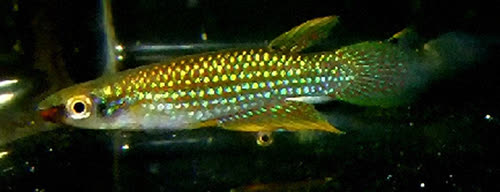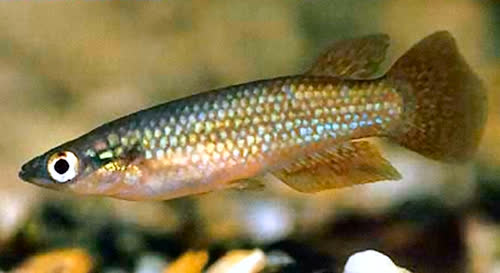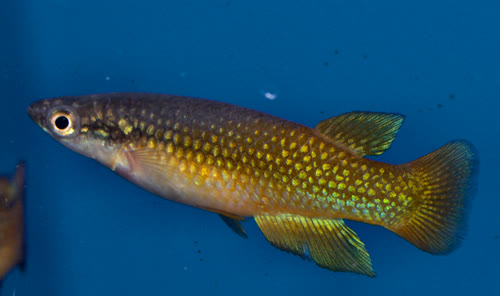|
|||||
| curve |
But notice that at 170mya North America was almost completely split off, it had begin this 220mya.
South America began splitting from Africa 105mya and by 90 mya was independent of it.
Thus, the split of Pachypanchax from Aplocheilus is the most recent major split in the killifish family tree. We're accustomed to thinking of Aplocheilus as ancient and at one time the idea prevailed it was the probable ancestor of all killifish - Scheel himself held this view.
But in reality they were the last to change not the first. North American killies are the oldest, then South American, then African then Aplocheilus. Pachypanchax may not look much different from when Africa was connected to Madagascar and, frozen in time on that island it gives us a good idea of what a snapshot of one branch of the killie family tree looked like about 100 million years ago. similarly to you have to keep in mind there were three great divisions of the killi family tree, literally. North America, South America, Africa and finally, India.
This what we one time thought was the ancestor of all killie is in fact the most recent clade to form. This shift in thinking was due to D. Lynn Parenti whose 1981 thesis on the Osteological structure of all killifish genera was not only proscribed by George S. Myers, but shows that Pachypanchax was indisputably the most ancient form, as Paul Loiselle, who has studied these more than anyone, "they are dinosaurs in every sense of the word".
Killies on Madagascar had little reason to change, the ones on the par
 170mya. All the continents are still connected |
 150mya. Africa and South America begin to crack at the northern end and as the continents begin to drift apart a split opens and you can see the tip of southern Africa clearly now. Killifish began in that sea formed by the tip of Africa, the tip of South America and Antarctica - which might have fossils of these. |
 120mya. A piece of the antarctic break off. |
 105mya. India and Madagascar begin to split |
 90mya. India and madagascar now splt at the north. |
 65mya. India keeps going until it comes to rest where it is now on the Asian subcontinent. |
From this we get a suggestion Aplocheilus split from Pachypanchax 90 million years ago and by 65 million years ago had been completely geographically isolated from each other.
By 120mya South America was nearly split from the African continent and by 105mya they were complerely separate.
Completely isolated from all other life evolution slowed down as there were far fewer things to adapt to. The Pachypanchax that were in India where were the same as the ones in Madagascar before the split began changing in their new surroundings and became Aplocheilus while Pachypanchax still in Madagascar didn't really change.
The geography of Madagascar is fairly simple, it's a thousand miles long and there's mountains in the middle. The east coast is a permanent rain forest because of the moisture laden air blowing from  the Indian Ocean. Bedotia are found here. The west cost is dry and sandy. Pachypanchax live here except for the one location where one species lives on the other coast.
the Indian Ocean. Bedotia are found here. The west cost is dry and sandy. Pachypanchax live here except for the one location where one species lives on the other coast.
Madagascar is home to the Tenerec, the insectivore that is the smallest mammal known and the most primitive of primates: the lemurs.
Or as Loiselle refers to them: "tree poodles".
I have a problem with the Lemurs, not that I do not like the Lemur, in fact I've never met a Lemur I didn't like, they're very amiable animals. But, mention you work in conservation in Madagascar and the first thing anybody says is "we have to save the Lemur". Well let me tell you something. Every Lemur known to science in 1900 is with us today and that is not true of the fish of Madagascar."- Paul Loiselle
Two species of Pachypanchax seem to have gone extinct in the same time frame as have other Malagasy fish.
|
Aplocheilus  |
Pachypanchax  |
"Myers (1933) based the genus Pachypanchax upon four diagnostic characters: (1) limited mobility of the maxilla, resulting from its attachment posteriorly by the skin to the postorbital region of the skull; (2) presence of unexpanded haemal arches; and (3) a rounded caudal fin whose (4) basal half is heavily scaled, the scales in straight rows, one scale wide, each series covering the interspace between two caudal rays. Myers placed particular emphasis on the caudal squamation of Pachypanchax, which he found to be unique among Old World aplocheilid cyprinodonts examined by him, and matched only by that of the Neotropical genus Austrofundulus."Loiselle 2006
Thus Austrofundulus is a missing link, it has not yet evolved any further with regard to caudal scalation any more than the Pachypanchax it evolved from.
encycloquaria.com